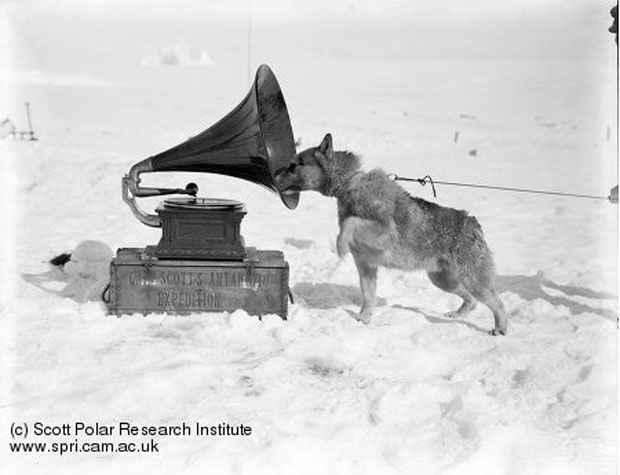An iconographic and text archive related to communication, technology and art.
☛ National Library of New Zealand: “Dog Chris, listening to the gramophone, Antarctica” by Herbert Ponting, b&w original photograph, silver gelatin print, 117 x 93 mm, circa January 1911. Part of Kinsey, Joseph James (Sir), 1852-1936 :Photographs relating to Antarctica and mountaineering / British Antarctic (“Terra Nova”) Expedition (1910-1913) album 2. Large format (3478 x 2700 px) can be retrieved here. DC Rights: not restricted.
The image is reminiscent of Francis Barraud’s famous painting of his dog Nipper listening to a gramophone horn. It has been suggested that the photographs (there are more than one) were taken as part as a voluntary effort to recreate Barraud’s painting (see Erik Østergaard: “The History of Nipper and His Master’s Voice”). It’s possible that it was done to fullfil a sponsorship agreement with the Gramophone Company. Many other commercial sponsors participated in the financing of the Terra Nova Expedition. The dog seen on Ponting’s picture was one of the many sled dogs used by the expedition.
Ponting’s photo was taken during the great Terra Nova Expedition (1910–1913) led by Robert Falcon Scott. Pointing was hired as the expedition official cinematographer and photographer. The following biography is retrieved from the brochure (PDF) accompanying the limited edition portofolio Captain Scott’s Antarctic Expedition 1910-1913. The Photographs of Herbert Ponting published by Salto Ulbeek in association with the Scott Polar Research Institute (University of Cambridge):
Herbert G. Ponting (1870-1935) was one of the most renowned photographers of his day when he was recruited as ‘camera-artist’ to the British Antarctic (Terra Nova) Expedition, 1910-1913.
Born into a wealthy Victorian family from Salisbury, Ponting worked briefly as a banker before moving to California and turning his attention to photography. During the first years of the 20th century, a number of assignments took him to the Far East. In 1904-1905, he photographed the Russo-Japanesse war in Manchuria, before continuing his travels in Japan, Burma, Java, China and India, selling his work to London’s foremost magazines. In 1910, he expanded his photographs of Japan into a book, In Lotus-Land Japan, which was published just before his departure for the Antarctic, and remains much sought after.
As a member of the Terra Nova Expedition, Ponting helped set up the Antarctic winter hut at Cape Evans on Ross Island, and was entitled to a tiny photographic darkroom in which he also slept. Working mostly with glass plate negatives, he set to work photographing all aspects of the expedition and of the environment around Cape Evans. During the winter of 1911, he took many photographs of Scott and the other members of the expedition in their hut, producing images that speak to us both within and beyond their historical context. With the start of the 1911-12 sledging season, Ponting’s field work began to come to an end. As a middle-aged man, he was not able to take part on the inland trek to the South Pole, and after 14 months at Cape Evans he boarded Terra Nova in February 1912.
Ponting returned to London where he set to work shaping a visual narrative of the expedition for Captain Scott to show during his lectures upon his return. This was not to be, however, as Scott and four of his men perished on their return from the Pole.
According to the Scott Polar Research Institute (University Cambridge) there a 10 photos showing the dog Chris listening to the gramophone (including the one shown above). Four of those are available on their website (record P2005/5/1176 through /1179). The other six have not been made available in an electronic format, but their record nonetheless have identifying information as well as a short description (record P2005/5/1715 through /1720). The version I posted above corresponds to record no. P2005/5/1176 in the SPRI’s Picture library catalogue. The three other versions available are displayed below:



To discover more of the photographs taken by Herbert Ponting during the Terra Nova Expedition, consider the following resources:
-
The Scott Polar Research Institute has a gallery of 2913 photographic items related to the British Antarctic Expedition 1910-13 (the official name for the Terra Nova Expedition). Pictures are presented in a small format and are not downloadable. However, they come with proper identification and a short description, which can be usefull for research purpose.
-
The National Library of New Zealand has 101 images related to Herbert Ponting. They all come with a full record. Furthermore, personal use is not restricted (only commercial use is) and they can be downloaded in a very large format (sometimes above 3000 px in width).
-
Wikimedia Commons has 40 images by Herbert Ponting. All those reproductions are in the public domain.
-
The National Archives UK’s photostream on Flickr has a set of 80 photographs by Herbert Ponting. They all come with a detailed description and a link the The National Archive’s online catalogue. The photos have no “known copyright restriction”.
-
The Picture Library of the Royal Geographical Society has 813 images by Herbert Ponting. Images are properly identified, but they come in a really small format and are heavily watermarked.
-
Finally, it’s worthing noting that Ponting released a film in 1924 about his Antartic adventures titled The Great White Silence (IMDb). The film was carefully restored and re-release in 2011 (see Wikipedia: “The Great White Silence”).
• • •
You might also like: Icelandic photographer Ragnar Axelsson (a.k.a. RAX)
- By Philippe Theophanidis
- on
- ― Published in Art, Photography, Technology
- Tagged: Antartic, dog, gramophone, Herbert Ponting, Music, Robert Falcon Scott, Terra Nova Expedition

